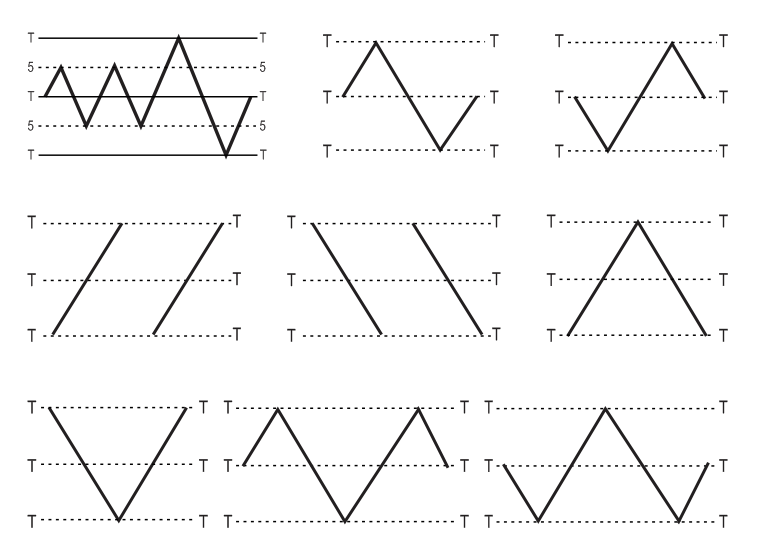Scale MUSICARTA City
Two-octave Scales
The All-black-key Majors
This page is part of Musicarta's 'Scale City'. If you have not already done so, browse the series home page for orientation, and work methodically for maximum benefit.
You should already have worked through the introductory two-octave scales page. This page applies the practice template to the major scales which use all five black keys - B major, D flat major and G flat major (enharmonic F sharp).
The scale practice Contour Diagrams
Here are the Contour Diagrams for the scale practice routine here demonstrated. Try, as much as possible, to play from the pattern, rather than following the notes.
There is 'from the middle' pattern [U2 D2 U3 D3 U4 D4 U2 D2] first - no diagram.

The three all-black-key major scales - B major, D flat major and G flat major (enharmonic F sharp) - all have the same fingers on the black keys.
Right hand fingers 2-3-4 on the group of three black keys, and 3-2 on the group of two
Left hand fingers 4-3-2 on the group of three black keys, and 3-2 on the group of two
The thumbs in both hands always play a white key between these groups of black keys - that is, both hands play two white keys in the octave. These are different for the three scales.
B major
B major uses all the black keys - as sharps - plus white keys B and E.
In the sharp keys, the last sharp in the key signature gives the major seventh of the scale, so the tonic is a semitone above that - in this case, a semitone above A sharp, that is, B.

Build up "from the middle thumbs", pausing the video to practice each pattern.
Now try to play some B major scales from just the contour diagrams (above).
D flat major
D flat major has all five black keys, this time as flats, and uses white keys F and C.

Practice the patterns in the video one by one.
G flat major
The G flat major scale has six flats in the key signature.
Five of these cue all the black keys, but the sixth flattens the white-key C to the key we usually call 'B'.

If these same keys are written in the enharmonic (= "sounds the same") F sharp major, then the E is sharpened - raised a semitone - and you play the key you would usually call 'F'.

Practice the patterns in the video one by one. Remind yourself that the 'convenience fingering' LH2 would be a LH4, to carry on up the keyboard.
Check the reliability of your scale fingering by playing the patterns from the contour diagrams.
Regular practice
You have now worked through all the major scales over two octaves, and can, in theory, play any two-octave major scale direct from the contour diagrams.
That is, if your first effort doesn't succeed, you should quickly be able to move to a better performance.

Once you have a good intellectual grasp of how the fingering adapts to stitch two octaves scales together, you can, in theory play any number of octaves.
If you haven't already tried them, you might like to introduce contrary motion scales into your scale practice options.
Click through to get started, or to use the contrary motion contour diagrams to stimulate your practice.
Thanks for learning with Musicarta! Come back soon!
|
Musicarta Patreon
SCALES SERIES
Reference
Scale fingering
Scale Practice Patterns (SPPs)
Scale-tone practice patterns (STPPs)
Chromatic Scales
Diminished Scales
|
The MusicartaA methodical approach to keyboard syncopation for
|
PUBLICATIONS
exciting keyboard
creativity courses
CHORDS 101
WORKBOOK

~HANON~
video course

Musicarta
Patreon
PENTATONICS
WORKBOOK
video course

Creative Keyboard
video course

BEAT AND RHYTHM
WORKBOOK

- Volume 1 -

12-BAR PIANO
STYLES WORKBOOK

MUSICARTA MODES
WORKBOOK

PIANO STYLE

CANON PROJECT
video course

VARIATIONS
video course


- Piano Solo -
video course

- Piano Solo -


YouTube playlists





 THE LOGO
THE LOGO
